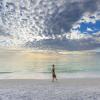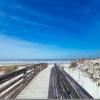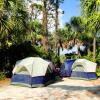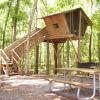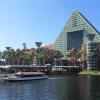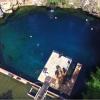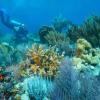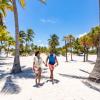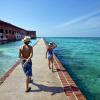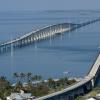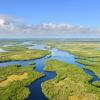A quick reference to the birds of Florida, from the common to the rare.
Florida's diverse habitats are home to a wide variety of plumed citizens, from tiny hummingbirds to huge herons and seed-eating buntings to predatory hawks.
Here's a general guide to our feathered families in taxonomical order, according to their natural relationships.
Find out even more at the Florida Fish and Wildlife Conservation Commission.
Swans, geese and ducks
Water birds with short legs and webbed-front toes. Among the most popular are the Florida mottled duck, wood duck, and black-bellied and fulvous whistling ducks. Winters bring more than 15 other visiting species, such as pintails, American wigeon and more.
Turkeys and quail
Prevalent year 'round. Wild turkeys are most commonly found in or near forests and swamps throughout the state. Their mostly dark plumage occasionally exhibits colorful metallic hues in sunlight.
Loons
Heavy diving birds with spear-shaped bills and webbed feet set far back on their bodies. The common loon inhabits the Atlantic Ocean and Gulf of Mexico from November through April. Red-throated loons are also rare winter visitors on the northern gulf coast.
Grebes
Diving birds with lobed feet and tufted tails. The Pied-billed grebe is a full-time resident in freshwater lakes and marshes. Horned grebes are statewide visitors from October - April. Western grebes are rarely sighted from January - March off the coast from Fort Desoto Park (Pinellas County) to Fort Myers. Eared grebes are much less common winter visitors, sighted mainly in the Panhandle.
Petrels, shearwaters and storm-petrels
Far-ranging, ocean-going globetrotters and can be seen off the coast on pelagic (deep sea) birding trips. Several, including Audubon's shearwater, are summer residents.
Tropicbirds, boobies and gannets
The white-tailed tropicbird, named for its streaming tail feathers, is regularly seen in the Dry Tortugas during spring. Northern gannets can be seen in the northwestern and northeastern beaches, plunging like brown pelicans into the water from October to April. Masked boobies inhabit the Dry Tortugas.
Ibises, spoonbills and storks
Found in Florida's wetlands and swamplands, mangroves and marshes. The roseate spoonbill is bright pink with a broad, flattened bill and can be seen throughout the state in summer.
Pelicans, cormorants, anhingas and frigatebirds
Waterbirds found throughout most of the state. While anhingas prefer freshwater, pelicans, cormorants and frigatebirds are more marine in nature. Frigatebirds travel from southern Florida to more northerly locations, like Cedar Key, in spring and summer.
Herons, egrets and bitterns
Long-legged and usually, long-necked, these wading birds are distributed throughout the state in saltwater and freshwater marshes. Uncommon reddish egrets occur in salt marshes throughout the state in spring and summer.
Vultures, hawks and allies
Four kite species included. Swallow-tailed kites are spring and summer residents; snail kites are specially adapted to feed on apple snails in Florida freshwater wetlands year 'round.
Rails, gallinules, coots and cranes
Includes the limpkin, a Sunshine State specialty. Combining characteristics of cranes and rails, it inhabits freshwater streams, swamps and lake margins. This year-round resident has a long bill, olive legs and brown, white-flecked body.
Plovers, sandpipers, gulls and terns
Shorebirds. Snowy plovers breed in the state, piping plovers winter here; gull-billed terns are a rare but sought-after species likely on Florida beaches. Least terns nest throughout the state on their traditional beaches as well as on gravel-topped roofs at the coast and inland.
Pigeons and doves
Seed- and fruit-eating land birds. White-crowned pigeons, a threatened species, are found in the Keys and extreme south Florida, and nest on mangrove islands free of raccoons.
Cuckoos and anis
Long-tailed birds. The Mangrove Cuckoo is a year-round resident of south central and south Florida mangrove habitats, and is distinguished by its buff breast and black mask.
Owls
Have large eyes, a short, hooked bill and strong legs and talons, and are mostly nocturnal birds of prey, though Florida burrowing owls hunt during the day and live in burrows underground. While they occur statewide, they are more likely found from Ocala southward in large, grassy fields.
Goatsuckers
Include nighthawks, Chuck-will's-widows and whip-poor-wills. The Chuck-will's-widow is a spring and summer resident of central and south Florida's woodlands, and is frequently identified by its call, which sounds like its name.
Swifts and hummingbirds
Include the ruby-throated hummingbird, Florida's smallest bird. It has an iridescent green back and the male sports a fiery red throat. Mostly year-round residents of central and south Florida, they are found in a wide variety of habitats.
Kingfishers
Are seen throughout the state in fall, winter and spring. Find them at marshes, swamps, wet prairies and agricultural areas. The belted kingfisher is a chunky, slate blue bird with a large bill and crested head.
Woodpeckers
Common in Florida. The Pileated Woodpecker is the state's largest, adapts to a variety of habitats and is a permanent resident. It is striking in appearance and has a red crested head, white throat and white stripe.
Flycatchers and larks
Perching birds that hunt insects on the wing. Florida's smallest breeding flycatcher is the Acadian flycatcher, an inhabitant of swamplands and moist woodlands from central Florida through the panhandle, seen April through September.
Vireos
Occur here in 10 varieties; Black-whiskered vireos inhabit coastal mangrove and hardwood habitats in the southern peninsula. Seen in spring and summer, they have black "whiskers" and a heavy bill.
Jays and crows
Include Florida's only endemic, the Florida scrub-jay. See it year 'round in coastal and inland scrubs throughout the peninsula. Unlike the blue-jay, it lacks a crest and has blue and tan instead of blue and white plumage.
Martins and swallows
Prefer open areas near water. The barn swallow is one of the best known. It has slate blue wings and head, and a dark orange throat and forehead; see it from April through November.
Chickadees and titmice
Small, curious woodland birds. The Carolina chickadee is a common resident except in South Florida; Tufted titmice live in cypress swamps, hardwood hammocks, longleaf pine sandhills and suburbs.
Nuthatches, creepers and bulbuls
Include the often upside-down White-breasted nuthatch. It is now mainly confined to northwest Florida. It has a black crown, white face and white breast.
Wrens
Prefer dense shrubbery and brush piles. The marsh wren inhabits salt marshes on the Gulf and Atlantic coasts in the northern two-thirds of the state year 'round. Brown with white streaks and white eyebrows, they are most often found by their rapid, liquid, musical call.
Kinglets and gnatcatchers
Kinglets have smaller tails. The ruby-crowned kinglet may be seen throughout Florida woodlands in all seasons but summer.
Thrushes and allies
Include the eastern bluebird, a small, blue resident that thrives in dry pinelands and increases in number when joined by northern migrants in winter.
Mockingbirds, thrashers and catbirds
Statewide residents. The northern mockingbird is Florida's official state bird and can imitate the songs of other birds and some animal and man-made sounds. Brown thrashers and catbirds also mimic other birds' calls.
Pipits, waxwings, shrikes and starlings
Visit at different times; the loggerhead shrike is here all year. This black-masked bird is a powerful flyer and formidable predator, earning the name of "butcherbird" for its ability to take everything from large insects to small birds.
Warblers
Comprise a large family, with nearly 43 varieties occurring here. The northern parula is widespread and breeds south to northern Monroe County. Small, colorful and vocal, it is seen February through September in hardwood swamps, hammocks and forests.
Tanagers
Seen throughout the state but are most common in the Panhandle. The red-plumed summer tanager nests in large dogwood, oak and pine trees from March through November.
Sparrows
More diverse in the winter. The Bachman's sparrow, however, is a year-round resident north of Lake Okeechobee and can be seen in pinelands with an understory of grasses and palmetto. This small, inconspicuous bird has a beautiful song that sounds like "heeeere- kitty-kitty-kitty-kitty!"
Cardinals, grosbeaks and allies
Include the brightly colored painted bunting, which breeds in coastal, maritime hammocks from Fernandina Beach to Merritt Island, and winters from south Florida to the Caribbean.
Blackbirds and allies
Include the orchard oriole, a summer resident that breeds in open, deciduous woodlands and suburbs in the northern peninsula and panhandle. Males are mostly black with rusty red undersides and rump; females are greenish-yellow with gray wings.
Finches and allies
Mostly winter visitors. The pine siskin, seen in north Florida, has boldly streaked plumage and a sharp, pointed bill. House finches are slowly expanding their range southward into the peninsula where they breed in urban/suburban areas.
